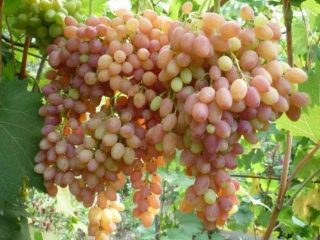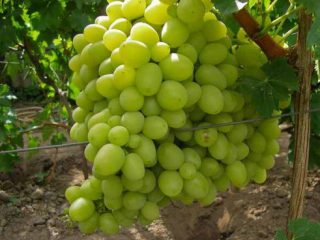Content
The Kishmish Nakhodka grape is a variety that knows how to surprise its owners, and therefore is constantly in demand. Agricultural technology for the disease-resistant Nakhodka grape variety is simple, but requires care. Nakhodka can tell you what a variety needs for maximum yield.
When choosing grapes for a summer cottage based on photographs and reviews, you should pay attention to the amazing success of the Kishmish Nakhodka grape variety - sold by gardening companies from Kaliningrad to Vladivostok! Love for the variety is associated with the excellent taste of the berries, high yield, and the beauty of the clusters. In addition, the Kishmish grape variety can forgive agrotechnical mistakes. Even with the most inept care, the grapes will retain their “face” - their presentation. But Nakhodka will always remind you of itself - first with rudiments, then with real bones. Nakhodka will repay those who have learned to understand it with boundless love.
Pomology
Amateur breeder V.N. Krainov, creating the Kishmish Nakhodka variety, instilled in him the best qualities of his parents (Talisman x Kishmish Radiant). High yield - 6-7 kg per bush. The early ripening period for Nakhodka grapes is the end of August. A bunch of grapes – 500-700 g, cylindrical-conical. Berries – 5-7 g, equal in size.
The grape pulp is sweet, muscat-colored. Increased acidity of berries is a lack of sun and microelements.
Increased resistance of Nakhodka grape variety to diseases. Frost resistance – minus 23°С.
Landing
The timing of planting Nakhodka grapes depends on the region: South of the country - spring-autumn; Central Russia, North - second half, end of May.
The Kishmish Nakhodka grape variety will be sweet if it gets a place to grow near a southern wall or fence. The quality of the fruit of a variety is influenced by the soil. The Nakhodka variety bears fruit well on light, fertile sandstones.
Additional processing is required: sand - adding humus and compost at the rate of 2 buckets per 1 sq. m. m; heavy clay - sand 1 bucket, compost 3 buckets per 1 sq. m.
When groundwater is close, grapes need drainage.
The roots of Kishmish grape varieties develop well in deeply loosened soil. To do this, dig a planting hole - 100-120 cm deep, with square sides - 100 cm. If you plan to plant several bushes, then the distance between: plants - 150-200 cm, rows - 200-250 cm.
For better water permeability, the bottom is covered with broken red bricks, chopped dry branches, plant debris - a layer of 20-25 cm. The top fertile layer mixed with humus - 2-3 buckets, the hole is filled to the middle. The remaining soil mixture will be needed when planting the seedling.
Grape trellises for the Kishmish Nakhodka grape variety must also be prepared in advance. The support pillars are 250 cm high, buried 65-70 cm, the distance between them is 250 cm. Galvanized wire with a diameter of 3 mm is fixed in 4 rows. The first one is 40 cm from the ground, the subsequent ones are 40-50 cm apart.
For a small vineyard - 2-3 bushes, instead of wire, you can use half-bars 50x50 mm.
Shelter from frost - a simple ditch or a specially built box, for the Nakhodka variety, planted in central Russia, should be prepared simultaneously with the supports.
When the soil temperature is 10-12°C, planting is carried out. The best planting material for Kishmish varieties are considered to be 1-2 year old seedlings with a closed root system, purchased from trusted suppliers.
The cutting is removed from the container without disturbing the coma. Installed in a hole, filled with the remaining mixture, watered with 1 bucket of water.
The open root system of cuttings of the Kishmish variety requires pruning: intact roots - up to 15 cm, diseased roots are cut out completely. 3-4 buds are left on the shoot.
A mound is made in the planting hole. A seedling is placed on the top, spreading the roots along the slopes.
Carefully pour water - 0.5 buckets, cover with the remaining soil mixture. The grafting site for cuttings of the Kishmish variety should be above ground level. Press the seedling tightly, water – 0.5 buckets, mulch the soil.
Trimming
Kishmish grape varieties lend themselves well to bush formation, which can be:
- Fan;
- Cordon;
- Gazebo;
- Sleeveless.
A fan formation is considered convenient for work. Right formed grape bush Kishmish Nakhodka has 4-6 sleeves of different lengths, fanning out from the base.
Fan formation begins from the first year of the Nakhodka grape seedling, on which 2-3 shoots are left. In the second year, the shoots are cut off before the buds open, leaving 2-3 eyes. The strongest ones - future sleeves - are tied to a trellis, the rest are removed.
In the third year, pruning is carried out based on the presence of shoots. With 4-6 shoots, pruning is carried out to a length of at least 50 cm. When 2 shoots are formed, pruning is carried out to a length that can accommodate 3-4 eyes. If the bush has 3 shoots, then 1 is formed as a replacement: 2 are cut to the length of the sleeve, 2-3 eyes are left on the replacement. The shoots are tied up obliquely - like a fan.
Numerous summer shoots of the Nakhodka variety are broken off, keeping the upper branches on the sleeves. Those left - as they grow, are tied obliquely to the trellis.
From the shoots at the end of the sleeves, fruit links are formed in the fourth year. In each, the top shoot is removed. Of the remaining ones: the bottom one is cut off by 2-3 eyes, 5-8 eyes are left on the other.
A replacement for fruit-bearing vines of the Nakhodka variety is prepared from annual shoots with 2-3 eyes, left at the base of the bush. Since wounds do not heal, pruning should be done carefully, at a right angle.
The remaining Nakhodka grape shoots should be well-ripened, of medium thickness, with short internodes, intact, and without signs of disease.
Nakhodka grape bushes covered for the winter are pruned twice. Autumn – preliminary, with the removal of fruit-bearing, immature, diseased shoots. Spring – final, forming the bush.
Care
The first three years, which require care, are considered important stages in the development of Nakhodka grapes.Care for a young bush is ensured by timely:
- Watering;
- Loosening;
- Feeding.
The root system of grapes is deeply penetrating. Nakhodka grapes are drought-resistant. But the bushes of a young vineyard, evaporating 98% of the moisture for cooling, require regular watering - without waiting for the leaves to wither.
Lack of moisture can affect adult plants of the Nakhodka grape variety - harvest formation is delayed. Excess water slows down the accumulation of sugar and inhibits shoot growth.
Loosening, combined with weeding, is carried out after each watering. It requires caution - young shoots of Nakhodka are easily damaged.
Nakhodka grape bushes grow quickly, requiring fertilizers for full development.
The best organic fertilizer is compost, which contains the necessary elements:
- Nitrogen – ensuring the growth of the vine;
- Phosphorus – promotes the development of the berry bunch;
- Potassium – accelerates the ripening of vines and fruits.
Compost can be used as mulch - a layer of 3-5 cm, without fear of overfeeding the grapes. Nutrients in a bound state are taken up by the roots of Nakhodka grapes to the extent necessary.
However, the use of mineral fertilizers that cause delayed harm to human health is undesirable. Wood ash contains the necessary replacement components: calcium - 40%, potassium - 12%, phosphorus - 6%. As well as a set of microelements - boron, iron, magnesium, manganese, molybdenum, sulfur, zinc, copper.
Diseases
The Kishmish Nakhodka grape variety is resistant to fungal diseases. However, climatic quirks can provoke infections:
- Mildew - downy mildew;
- Oidium – true powdery mildew;
- Phomopsis - black spot;
- Botrytis - gray rot;
- Alternaria;
- Anthracnose.
Overfeeding the Nakhodka variety with nitrogen contributes to outbreaks of downy mildew. Oily spots cover the outside of the leaves. Inner - whitish. The ovaries, flowers, leaves dry out.
A whitish-gray coating, which is a sign of powdery mildew, will appear on the leaves with sudden temperature changes. Passing on to the bunches, it causes cracking of the berries, which rot and dry out.
A damp summer can cause black spots to appear on the leaf blades of the Kishmish Nakhodka grape variety. Phomopsis leads to spoilage of berries and death of sleeves.
Dampness causes botrytis - gray rot.
Prolonged, humid heat causes brownish spots to appear on the leaves, accompanied by a silvery sheen to the berries. Alternaria causes wrinkled berries that are poorly stored.
Damp, cool May-June causes the development of anthracnose. Gray spots on leaves, inflorescences, and shoots lead to the death of the crop.
Pests
The victorious march of Nakhodka grapes from South to North is accompanied by hordes of insect pests:
- Leaf rollers;
- Scale insects;
- Pads;
- Grape Itch;
- Phylloxera.
The grape leaf roller is a small moth that lays eggs on buds, foliage, and ovaries. The voracious caterpillars can cause significant crop losses.
Scale insects, like aphids, stick to plants, suck out the juice, and weaken the bushes.
The cushion plant belongs to the family of pseudoscale insects. Settling on the underside of leaves, they feed on sap, secreting a whitish fluff.
The itch, a felt mite, 0.15–0.2 mm in size, colonizes the northern territories well.Sucking out the juices, it leaves behind a felt web. Infected leaves dry out. Productivity is decreasing.
A small yellowish aphid, phylloxera, is a quarantine pest. Lives mainly in the southern regions, but movements towards the North of the country are observed. Transported by planting material, wind, and animals. Capable of laying several hundred eggs per season. The larvae are voracious, sucking juices from the roots. The bush becomes depleted and quickly dies.
No less damage is caused to grape harvests: wasps eat the pulp, birds peck the berries.
Protection
The best way to protect Nakhodka grapes is to carry out agrotechnical measures. Properly formed bushes, planted at a sufficient distance, are well ventilated and illuminated by the sun.
Infusions help resist sucking insects:
- Garlic - leave a glass of crushed mass for 24 hours, add 50 g of soap, dilute in 10 liters of water;
- Ash - 1 glass of wood ash per 10 liters of water, leave for a week, add 50 g of soap;
- Laundry soap - against gray rot, 100 g of soap per 10 liters of water;
- Milk with iodine – 1 liter x 15 drops of iodine per 10 liters of water;
- Tar soap - a pack of soap in 5 liters of water, against scale insects.
Nylon mesh and bottles filled with meat broth and soured compote save you from wasps.
Birds are repelled by ribbons of shiny paper, thin pieces of white fabric, and vegetable nets.
Shelter
Fallen leaves serve as a signal for pruning the Kishmish Nakhodka grape variety, shelter for the winter. The vines are untied from the trellises, collected in bunches, attached to the ground, and covered with sawdust. Spruce branches will stop mice. Cover with roofing felt, cover with fallen snow, and lightly compact.
Reviews
Conclusion
The Kishmish Nakhodka grape is resistant to fungal diseases and is less affected by wasps. The variety reacts painlessly to erroneous pruning. The only thing that Nakhodka grapes do not tolerate well is neglect. Then the owner has to spit the bones.












